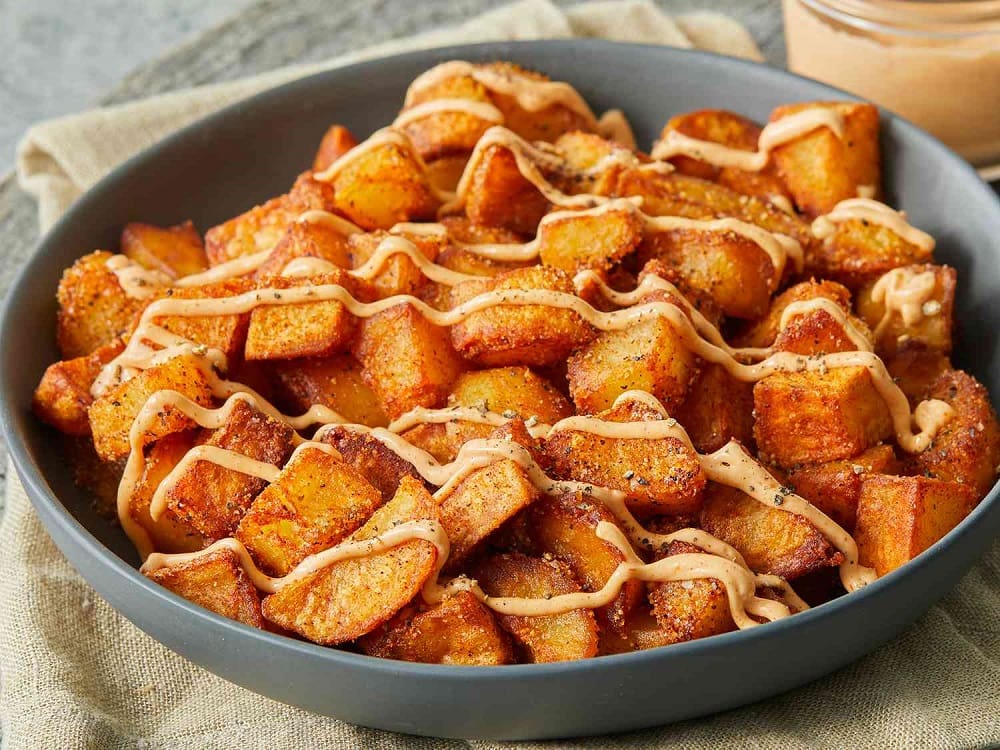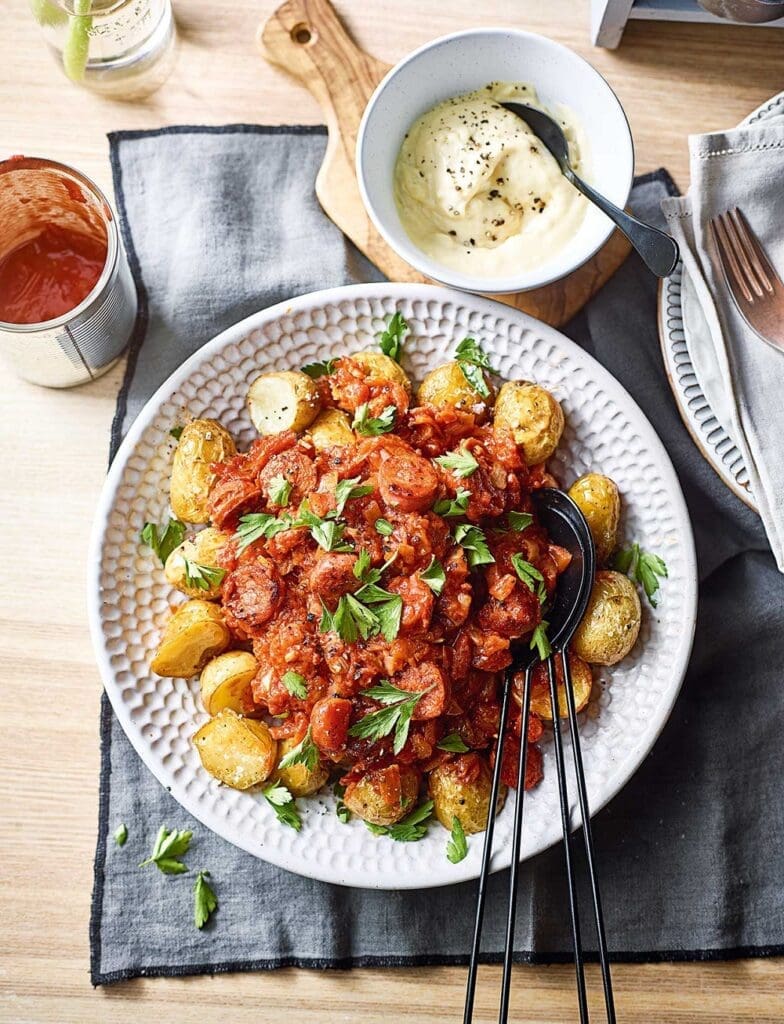

John Perez
“Patatas Bravas for Life!!”
A renowned Spanish chef and culinary writer, with a passion for traditional Spanish cuisine. With over 20 years of experience in the restaurant industry, John has worked in some of Spain’s most prestigious restaurants. His culinary journey has taken him from the bustling kitchens of Madrid to the tranquil vineyards of Andalusia, where he honed his skills and developed a deep appreciation for the rich flavors and diverse ingredients of Spanish cuisine. Now, he shares his love for food through his writing, providing authentic recipes and cooking tips on his blog. His approachable style and insightful tips make cooking Spanish cuisine accessible to everyone, from novice home cooks to seasoned chefs.
Patatas Bravas, a name that resonates with the vibrancy and spirit of traditional Spanish cuisine, is a dish that has won the hearts of food lovers worldwide. This popular Spanish tapa, which literally translates to “Brave Potatoes,” is a testament to the country’s rich culinary heritage and its love for simple, yet flavorful ingredients.
Originating from the bustling taverns of Madrid, Patatas Bravas has now found its place in the menus of Spanish restaurants across the globe. The dish is a delightful combination of crispy fried potatoes served with a spicy tomato sauce, known as “salsa brava,” and often accompanied by a dollop of aioli. The allure of Patatas Bravas lies in its contrasting flavors and textures, with the soft and fluffy interior of the potatoes perfectly complementing the tangy and spicy bravas sauce.
The popularity of Patatas Bravas extends beyond its taste. It is a dish that embodies the Spanish way of life – lively, communal, and full of zest. Whether it’s a family gathering, a friendly catch-up, or a festive celebration, Patatas Bravas is a staple that adds warmth and joy to every occasion.
In this blog, we will embark on a culinary journey to explore the history of Patatas Bravas, understand its significance in Spanish cuisine, and learn how to prepare this delightful dish at home. So, whether you’re a seasoned cook or a culinary novice, get ready to immerse yourself in the flavors and aromas of Spanish cooking as we delve into the world of Patatas Bravas.


Ingredients Needed for Patatas Bravas
Creating a delicious plate of Patatas Bravas starts with gathering the right ingredients. The beauty of this dish lies in its simplicity, and the ingredients required are straightforward and easy to find. Here’s what you’ll need:
For the Potatoes:
- Potatoes: You’ll need about 4 large potatoes. The type of potato you choose can impact the texture of your dish. Russet potatoes are a good choice due to their high starch content, which makes for a fluffy interior and a crispy exterior when fried.
- Olive Oil: Spanish cuisine heavily relies on olive oil, and it’s the preferred oil for frying the potatoes. You’ll need enough to deep fry the potatoes, which is typically about 2 cups.
For the Bravas Sauce:
- Tomato Sauce: You’ll need about 1 cup of tomato sauce as the base for your bravas sauce. Some recipes may call for crushed tomatoes or tomato paste, but tomato sauce often provides the right consistency.
- Spanish Onion: One medium-sized Spanish onion, finely chopped, adds a depth of flavor to the sauce.
- Garlic: Two to three cloves of garlic, minced, will infuse the sauce with its distinctive flavor.
- Spicy Paprika: This is what gives the bravas sauce its signature heat. You’ll need about 1 tablespoon, but you can adjust this to taste.
- White Vinegar: A splash of white vinegar, about 1 tablespoon, adds a tangy note to balance the heat of the paprika.
- Olive Oil: You’ll need about 2 tablespoons of olive oil for sautéing the onion and garlic.
For the Aioli (Optional):
- Garlic: Two cloves of garlic, minced, are the star ingredient in aioli.
- Egg Yolk: One egg yolk helps emulsify the aioli into a creamy sauce.
- Olive Oil: You’ll need about 1/2 cup of olive oil, added gradually, to achieve the right consistency.
- Lemon Juice: A squeeze of fresh lemon juice, about 1 tablespoon, brightens up the aioli and adds a touch of acidity.
How to Prepare Patatas Bravas
Now that we have our ingredients ready, let’s dive into the process of preparing Patatas Bravas. This dish involves two main steps: preparing and frying the potatoes, and making the bravas sauce. Here’s a step-by-step guide:
Preparing and Frying the Potatoes:
- Peel and Cut the Potatoes: Start by peeling the potatoes. Once peeled, cut them into bite-sized cubes. Try to keep the cubes roughly the same size for even cooking.
- Fry the Potatoes: Heat the olive oil in a deep frying pan or pot over medium-high heat. Once the oil is hot, carefully add the potato cubes. Fry them until they are golden brown and crispy on the outside, and soft and fluffy on the inside. This should take about 10-15 minutes. Be sure to turn the potatoes occasionally for even browning.
- Drain the Potatoes: Once the potatoes are cooked, use a slotted spoon to remove them from the oil. Drain them on a plate lined with paper towels to remove excess oil.
Your Spanish Journey Starts Here: Buenos Aires, Malaga, or Anywhere You Are
Are you ready to embark on a language adventure that’s as exciting as it is educational? Whether you’re yearning for the vibrant city life of Buenos Aires, the sun-drenched charm of Malaga, or the convenience of online learning, we’ve got just the ticket!


Learn Spanish in Argentina
Dive into the heart of Argentina with our Spanish school in Buenos Aires. Experience the city’s pulsating energy, rich history, and captivating culture as you master the Spanish language. Buenos Aires is calling – will you answer?
www.vamospanish.com/spanish-school-buenos-aires/


Learn Spanish in Malaga
Imagine yourself soaking up the Andalusian sun as you learn Spanish in Malaga. Our school offers a unique blend of top-notch education and laid-back beach vibes. It’s not just a language course – it’s your passport to the Mediterranean lifestyle!
www.vamospanish.com/spanish-school-malaga/


Learn Spanish Online
Can’t travel right now? No problem! Our online Spanish classes bring the language, culture, and fun right to your living room. Engage with our experienced teachers and enjoy interactive lessons from wherever you are in the world.
www.vamospanish.com/online-spanish-classes/
How to Prepare the Bravas Sauce
The bravas sauce, or “salsa brava,” is what gives Patatas Bravas its distinctive flavor. It’s a spicy tomato sauce that’s simple to make, yet packed with flavor. Here’s how to prepare it:
- Heat the Oil: Start by heating about 2 tablespoons of olive oil in a pan over medium heat. You want the oil to be hot enough to sauté the onions and garlic, but not so hot that it burns them.
- Sauté the Onion and Garlic: Add the finely chopped Spanish onion to the hot oil. Sauté the onion until it becomes translucent, which should take about 5 minutes. Then, add the minced garlic and continue to sauté for another minute until the garlic is fragrant.
- Add the Tomato Sauce: Pour in the tomato sauce, stirring well to combine it with the onions and garlic. The tomato sauce forms the base of the bravas sauce and gives it its rich, tangy flavor.
- Add the Spices: Stir in the spicy paprika. This is the key ingredient that gives the bravas sauce its signature heat. If you prefer a milder sauce, you can adjust the amount of paprika to taste.
- Simmer the Sauce: Allow the sauce to simmer on low heat for about 15-20 minutes. This will help the flavors meld together and will thicken the sauce to the perfect consistency.
- Add the Vinegar: Finally, stir in the white vinegar. The vinegar adds a tangy note to the sauce, balancing out the heat from the paprika. After adding the vinegar, let the sauce cook for another 2-3 minutes.
How to Serve Patatas Bravas
Serving Patatas Bravas is just as important as the preparation. Presentation can enhance the dining experience and make the dish even more enjoyable. Here’s how to serve Patatas Bravas:
- Plate Presentation: Start by placing the crispy, golden-brown potatoes on a serving plate or in a shallow bowl. Pour the warm bravas sauce over the potatoes, ensuring that each piece is generously coated. If you’ve prepared aioli, you can drizzle it over the top for an extra layer of flavor, or serve it on the side as a dipping sauce.
- Garnish: For a pop of color and freshness, garnish the Patatas Bravas with chopped fresh parsley or cilantro. You could also sprinkle some finely chopped red pepper for an extra kick.
- Serving Size: Patatas Bravas is traditionally served as a tapa, which is a small dish meant to be shared. However, it can also be served as a main dish. If serving as a tapa, consider using small plates or tapas dishes for an authentic Spanish dining experience.
- Pairing: Patatas Bravas pairs well with a variety of drinks. A cold Spanish beer or a glass of red or white Spanish wine would complement the flavors of the dish beautifully. For a non-alcoholic option, a chilled glass of Spanish sangria or a lemonade would work just as well.
- Serve Immediately: Patatas Bravas is best enjoyed warm, so serve the dish immediately after preparation. The contrast between the hot, crispy potatoes and the spicy, tangy bravas sauce is what makes this dish a crowd-pleaser.
Variations of Patatas Bravas
While the traditional Patatas Bravas recipe is a classic favorite, there are numerous variations of this dish that showcase the diversity and creativity of Spanish cuisine. Here are a few popular variations:
- Different Types of Potatoes: While russet potatoes are commonly used, other types of potatoes like Yukon Gold or red potatoes can also be used for a different texture and flavor.
- Baked Patatas Bravas: For a healthier twist, the potatoes can be baked instead of fried. This version is lighter but still delivers on flavor.
- Different Sauces: While the traditional bravas sauce is a spicy tomato sauce, some variations use other types of sauces. For instance, a garlic aioli or a spicy mayo can be used as alternatives or additions to the bravas sauce.
- Additional Toppings: Some variations of Patatas Bravas include additional toppings like crumbled chorizo, shredded cheese, or even a fried egg on top for a hearty twist.
- Regional Variations: Different regions in Spain have their own take on Patatas Bravas. For instance, in Catalonia, the bravas sauce is made with olive oil, red pepper, and vinegar, and served with aioli. In Valencia, the potatoes are cut into thin slices instead of cubes.
| Region | Variation |
|---|---|
| Madrid | Original version with fried potato cubes served with a spicy tomato-based bravas sauce. |
| Catalonia | Bravas sauce often includes aioli, a type of garlic mayonnaise. Potatoes are sometimes served with a separate spicy sauce. |
| Valencia | Potatoes are often cut into thin slices instead of cubes. The bravas sauce tends to be spicier. |
| Andalusia | Bravas sauce is often made with a mix of tomatoes, red peppers, and a variety of spices, resulting in a sauce that is both spicy and slightly sweet. |
| Basque Country | Potatoes are often cut into larger chunks. The bravas sauce is typically made with a base of olive oil and garlic, with the addition of spicy peppers for heat. |
What to Drink with Patatas Bravas
Pairing the right drink with Patatas Bravas can enhance the overall dining experience. Here are some suggestions:
- Spanish Beer: A cold Spanish beer like Estrella Damm or San Miguel complements the spicy flavors of Patatas Bravas perfectly.
- Spanish Wine: A glass of Spanish red wine, such as Rioja or Ribera del Duero, or a white wine like Albariño, pairs well with the hearty flavors of this dish.
- Summer Wine: A chilled glass of summer wine, which is typically light and fruity, can provide a refreshing contrast to the spicy and hearty Patatas Bravas.
- Non-Alcoholic Options: For those who prefer non-alcoholic drinks, a chilled glass of Spanish lemonade or a fruity mocktail would be a great choice.
Also read our Blog about Summer Wine also known as Tinto de verano: Tinto de Verano: All You Need to Know About “Summer Wine”
The Creation and History of Patatas Bravas
The creation of Patatas Bravas is deeply rooted in Spanish culinary tradition. This dish, which translates to “Spicy Potatoes,” is a classic Spanish tapa that originated in the mid-20th century.
The exact origin of Patatas Bravas is a subject of debate among food historians. However, it’s widely accepted that the dish was first served in Madrid’s taverns and bars in the 1960s. The creation of this dish is often attributed to a bar owner in Madrid who wanted to offer a new and exciting tapa to his customers.
The original recipe for Patatas Bravas is quite simple, involving only a few key ingredients. The main component of the dish is potatoes, which are cut into cubes and deep-fried until they are crispy on the outside and soft on the inside. The potatoes are then topped with a spicy tomato sauce, known as bravas sauce, which gives the dish its distinctive kick.
The bravas sauce is typically made with tomato sauce, spicy paprika, and often a splash of vinegar for a tangy note. The sauce is simmered until it thickens and the flavors meld together, creating a rich and spicy accompaniment to the crispy potatoes.
The dish quickly gained popularity due to its delicious flavors and the contrast between the crispy potatoes and the spicy sauce. It became a staple in tapas bars across Madrid and eventually spread to other parts of Spain.


What are you waiting for?? Come to Malaga, study Spanish and try this amaizing dish. 😉😉
Patatas Bravas, with its humble origins and simple ingredients, is a testament to the power of traditional cooking and the enduring appeal of comfort food. This classic Spanish dish, born in the taverns of Madrid, has traveled far and wide, winning hearts and palates across the globe.
The beauty of Patatas Bravas lies in its simplicity – crispy fried potatoes paired with a spicy, tangy bravas sauce. Yet, within this simplicity lies a depth of flavor that is quintessentially Spanish. The dish embodies the spirit of Spanish cuisine, which values quality ingredients, bold flavors, and the joy of sharing good food with good company.
Whether you’re enjoying Patatas Bravas in a tapas bar in Spain or cooking it at home, this dish is sure to transport you to the vibrant streets of Madrid, the lively Spanish fiestas, and the warm, bustling kitchens of Spanish homes. It’s a culinary journey that celebrates the rich heritage and the vibrant culture of Spain.
So the next time you’re looking for a dish that’s comforting, flavorful, and steeped in tradition, remember Patatas Bravas. It’s more than just a dish – it’s a slice of Spanish life served on a plate. Enjoy the journey, one bite at a time.




